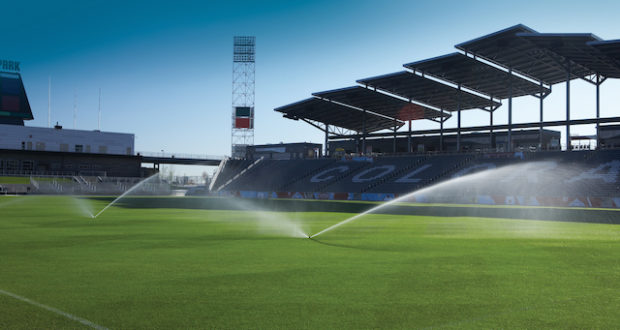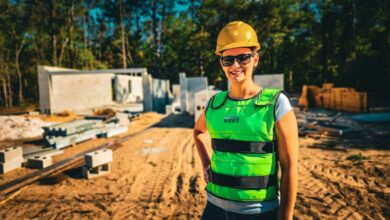Starting up parks and sports field irrigation systems in spring

When it comes to the startup of spring irrigation systems at large sports fields and municipal parks, careful planning goes a long way toward the successful seasonal start for fun and games.
No one knows this better than Michael Boettcher, director of grounds for the Milwaukee Brewers, and Abby McNeal, CSFM, operations supervisor at Ruby Hill Southwest District Denver Parks. Both Boettcher and McNeal say that proper winterization translates directly into how well you can expect your spring startup to go.
“A good spring startup starts with a good fall shutdown,” said Boettcher, who is in charge of Miller Park, a main field with a retractable roof structure, 60 acres of landscaping, and a Little League Field sitting on a 250-acre park.
“Baseball season starts April 1, so we try to get everything going around March 1 but Mother Nature doesn’t always think we should be doing that,” he added.
McNeal said the winterization irrigation shutdown of the 80-acre park, including six Tier A athletic ball fields, takes 4 to 5 weeks, and involves lots of deliberate planning. These preventive efforts are done for good reason.
“We rely on the strength of winterization to make our spring startup easier,” McNeal said, echoing Boettcher’s sentiments.
Boettcher and McNeal reveal their strategies from early preparations in the fall to actual steps for achieving a successful spring startup and offer valuable tips for dealing with potential issues, including the unexpected challenges of spring startup.
Careful planning
Before freezing conditions arrive at their respective homes in Lake Michigan and the Rocky Mountain areas, both Boettcher and McNeal say they blow out their irrigation network thoroughly with compressed air.
Boettcher relies on an outside company to blow out each system in November to get all the water out and prevent the water from freezing in the pipes.
McNeal said she hires a contractor to ensure the pump system, which is one large pump serving the entire park, functions properly. She relies on her own staff of six full-time employees and eight seasonal workers to complete the process of winterization and spring startup.
“Each park has a varied number of quick couplers,” she explained. “Depending on the size of the park, we have three to four quick couplers for smaller parks and up to 12 quick couplers for the larger parks. We start at the point of connection to turn off the incoming water, then use the quick couplers to drain the mainline. After that, we connect the air compressor and go station by station opening each one, using air to force the water out of the lateral lines.”
Only when the staff feels that all the water has been pushed out of the system will they turn off the compressor. Backflows that are two inches or smaller are removed and secured in a backflow cage over the winter. All this is necessary to ensure a safe spring startup, she noted.
Getting ready for spring startup
Boettcher said just like during fall shutdown, in the spring, he relies on an outside company to fire up the system.
“The benefits of hiring an irrigation company is that they know the intricacies of an irrigation system and can diagnose any issues that could be starting,” Boettcher explained. “They are trained professionals and having their trained eye look at our system is always great at the start of the year.” It also makes the process more efficient, he added.
A first visual inspection of the entire landscape system lets the company assess potential issues.
“Ninety-nine percent of the time, the system is ok after visual inspection, except for occasional head damage from the snowplows or from construction,” Boettcher said.
This is also the time to address issues that were already noted during their preliminary inspection in the fall.
“When we blow out the system, we look at the heads, and if there is little damage on seals of heads or nozzles, we make note of it. It’s not necessary to fix those issues before winter,” he said.
After the visual inspection of the landscape system, it’s time to begin filling the mainline. Boettcher said that he typically goes to the clock to fire up the system at the furthest zone from the water source. Slowly filling the system is key to allow all of the air in the pipes to evacuate through the quick coupling valves or sprinklers.
“Once the water is in the landscape system, we know the pipes are purged,” he said. He then starts firing up the individual zones and checks that the heads at the zones work as well, an area comprising 45 zones and some 500 heads total.
Boettcher said in his many years at Miller Park, he’s encountered very few issues with spring startup.
“The biggest problems were physically damaged heads and isolation valves that had gotten some particles stuck in their components, resulting in a leaky valve,” he said.
Meanwhile, in Denver, McNeal said she typically starts firing up her irrigation system around April 15, starting with the athletic fields.
“We have a small checklist we use as a guide,” McNeal said. She also encourages her staff to create their own documents with photos to ensure the system is ready.
“We work with our facilities plumbing staff for backflow issues and larger irrigation issues that may occur during startup or shutdown,” she said. “The contractor handles the pump system maintenance and startup.”
One of the trickiest parts of spring startup in Denver is timing, she noted. “It’s tricky in Colorado when the temperatures can reach 60 degrees in March, then drop to the upper 40s for a high and low 20s in April,” she said.
She said she watches the weather every spring to make the call, but noted while the larger backflows can handle the temperature swings, the smaller ones cannot. Knowing where the shallower pipes and smaller backflows are located is key to monitoring the system and prioritizing where water needs to be turned on and where not, she said.
Maintenance tips
Like Boettcher, McNeal said a good winterization process is the best policy for a trouble-free start into spring irrigation, but regular maintenance of the entire system is as important.
“We don’t just do our spring startup and leave it at that,” Boettcher said.
Weekly inspections of the grounds throughout the season ensure that the system is functioning properly and that issues are addressed as they come up. “Our managers do the inspection,” he said, primarily adjusting arc or spray patterns.
“The technology in spray patterns and irrigation distribution and overall quality construction of the heads has allowed for great success of our irrigation system throughout the entire site,” he noted.
When baseball season hits, the pressure is also on McNeal and Boettcher to get their large irrigation systems up and running, so the fields will be green and playable and the fans can enjoy the games.
Spring startup checklist
This checklist for spring startup for automatic irrigation systems is courtesy of Lynda Wightman, industry relations manager for Hunter Industries:
Automatic Controllers:
In all climates, certain yearly procedures should take place with your control system.
Change battery and/or fuses
Check wiring compartment for any rodent damage, etc.
Change battery and check wiring for remote control units
Plug in controller and run through each zone (in winterized climates)
Check for current date and time
Create spring watering schedule on controller
Check the sensing devices: rain shutoff; ET; wind, etc.
Electric Valves:
Check wiring and waterproof connectors for wear, rodent and water damage, etc.
Open flow control handle to maximum, and then turn back down 1½ turns for optimum open and closure speeds
When operating valves manually/electrically from controller, check to make sure each valve opens and closes with appropriate speeds
If valve doesn’t close, check solenoid and diaphragms for debris or damage
Clean out valve boxes and put new gravel in bottom of box
Sprinklers:
While sprinklers are running, check for proper arc alignment (not spraying on hardscapes, other landscapes, etc.)
Take a dynamic pressure reading while sprinklers are running to ensure proper operating pressure
Raise and/or lower sprinklers to appropriate depth. Sprinklers buried too low will invite liabilities/accidents and will not allow water to clear tops of turf and plant material. Sprinklers buried too high are unsightly and may cause liabilities and vandalism.
Check nozzles for clogging and matched precipitation
Add drain check valves, if necessary
Clean screens in bottom of sprinklers
Miscellaneous equipment:
Make sure all isolation valves (ball and/or gate valves) are open and allow water to flow freely through them
Re-install backflow prevention device (in Northern regions) and have a professional conduct proper safety checks
Check for leaks in hose bibs, quick couplers, etc.
Ongoing maintenance:
Develop a “checklist” that can be quickly and easily conducted for ongoing system maintenance. This list can be laminated and re-used with a dry erase pen on a monthly basis. Following is an example that can certainly be customized to meet an individual’s specific needs.
- Adjust heads to correct grade
- No missing heads or broken sprinklers
- No dissimilar sprinklers zoned together
- No interference to sprays by landscaping materials
- Annual equipment inspection
- Check filter screens
Don’t forget that an efficient irrigation system relies upon an even distribution of water, the entire year. Site inspections are “cheap insurance policies.” Get out and take a visual look at your sprinklers at least once a month to ensure a safe and healthy playing surface. It is also critical to hire irrigation professionals that are Irrigation Association-certified to ensure your work is done properly.
This article was supplied by Hunter Industries.


